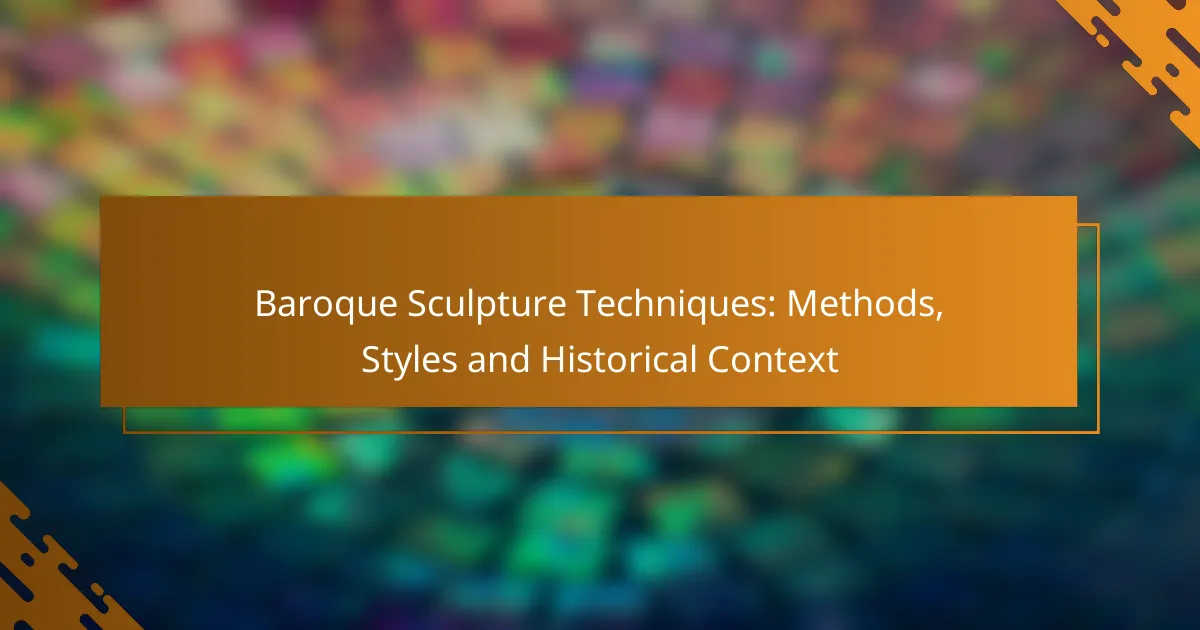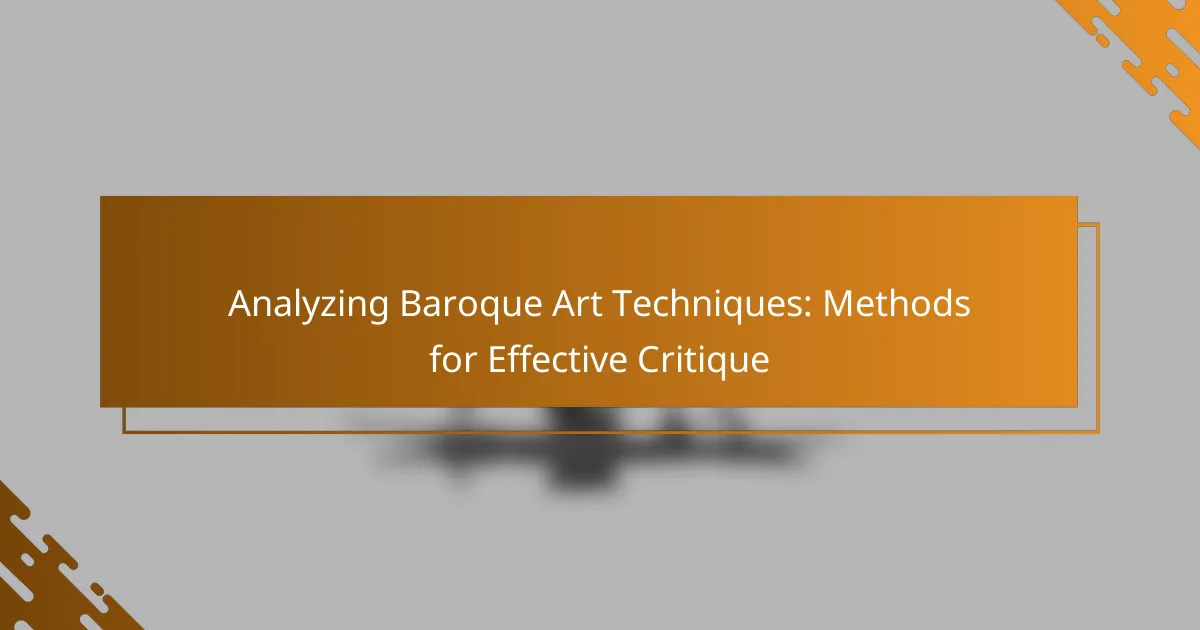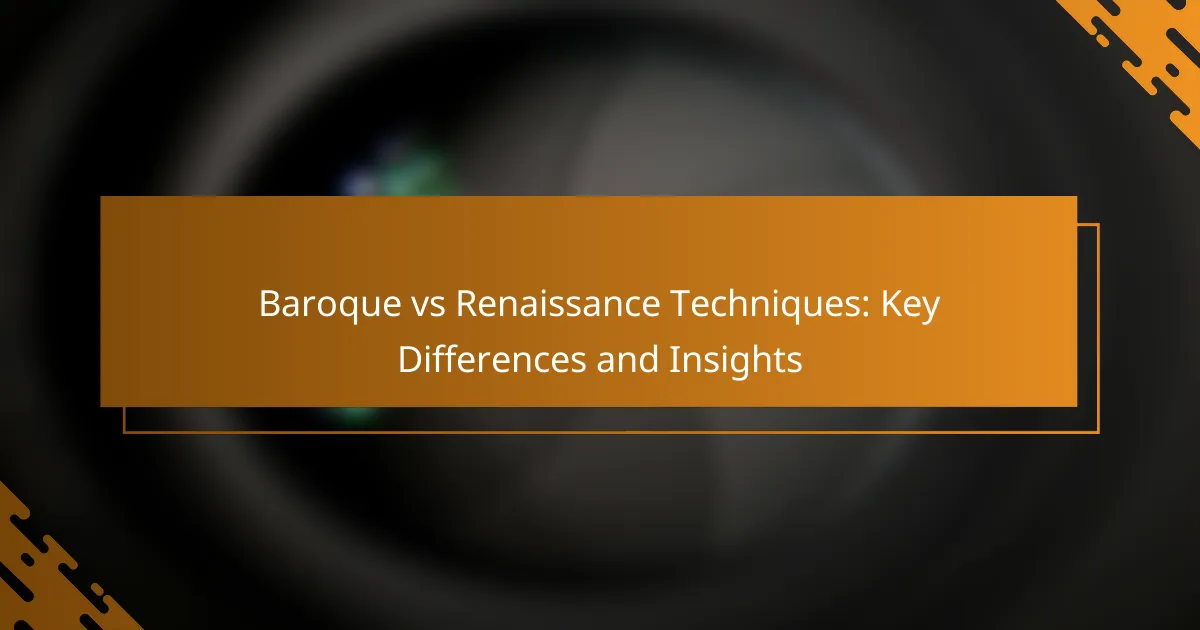Baroque sculpture, flourishing in 17th-century Europe, is renowned for its dynamic forms and emotional intensity, reflecting the socio-political and religious upheavals of the time. Key techniques such as chiaroscuro, contrapposto, and polychromy enhance the realism and dramatic expression of these works, allowing artists to engage viewers deeply. Notable figures like Gian Lorenzo Bernini exemplify this style, creating masterpieces that capture the essence of the Baroque era.

What are the key Baroque sculpture techniques?
Key Baroque sculpture techniques include chiaroscuro, contrapposto, in-the-round versus relief, polychromy, and various methods of carving and modeling. These techniques enhance the dramatic expression and realism characteristic of the Baroque style, allowing artists to create dynamic and engaging works.
Chiaroscuro
Chiaroscuro is the technique of using strong contrasts between light and shadow to create a sense of volume and depth in sculpture. This method enhances the three-dimensionality of figures, making them appear more lifelike and dramatic. Baroque artists often employed chiaroscuro to draw attention to specific features and evoke emotional responses from viewers.
To effectively use chiaroscuro, sculptors would consider the light source and how it interacts with the surface textures of the material. For example, a polished surface might reflect light differently than a rough one, affecting the overall visual impact.
Contrapposto
Contrapposto is a pose in which a figure stands with most of its weight on one foot, creating a sense of movement and relaxation. This technique allows for a more naturalistic representation of the human body, as it mimics the way people naturally stand and shift their weight. Baroque sculptors utilized contrapposto to convey dynamism and emotional tension in their works.
When implementing contrapposto, artists often focus on the alignment of the hips and shoulders, ensuring that the figure appears balanced yet relaxed. This technique can be particularly effective in creating a sense of narrative within the sculpture.
In-the-round vs. Relief
In-the-round sculptures are fully three-dimensional and can be viewed from all angles, while relief sculptures are partially carved and meant to be seen from one side. Baroque artists frequently used both techniques to achieve different effects; in-the-round works often convey a greater sense of realism and engagement, whereas reliefs can tell stories through their composition and depth.
Choosing between in-the-round and relief depends on the intended display context and the narrative goals of the piece. For instance, in-the-round sculptures are ideal for public spaces, while reliefs are often suited for architectural settings where they complement the surrounding structure.
Polychromy
Polychromy refers to the practice of applying multiple colors to sculptures, enhancing their visual appeal and realism. Many Baroque sculptures were originally painted to imitate the appearance of flesh and clothing, adding a layer of vibrancy and life. This technique was particularly popular in wooden sculptures and those made from materials like marble.
When using polychromy, artists must consider the durability of the pigments and how they will age over time. It is essential to select high-quality materials to ensure the longevity of the colors, as fading can detract from the sculpture’s intended impact.
Carving and Modeling
Carving and modeling are fundamental techniques in Baroque sculpture, involving the removal of material or the addition of clay to create forms. Carving typically involves subtractive methods, where artists chip away at stone or wood, while modeling is an additive process, often using materials like clay or wax to build up shapes.
Baroque sculptors often combined these techniques to achieve intricate details and textures. For example, a sculptor might carve a stone figure and then model fine details in clay for a mold. Understanding the properties of different materials is crucial for achieving the desired effects in both methods.

How did Baroque sculpture evolve in Europe?
Baroque sculpture evolved in Europe during the 17th century, characterized by dynamic forms, emotional intensity, and intricate details. This evolution was influenced by earlier artistic movements, particularly the Renaissance, and was shaped by the socio-political and religious contexts of the time.
Influence of the Renaissance
The Renaissance laid the groundwork for Baroque sculpture by emphasizing realism, human emotion, and classical themes. Artists like Michelangelo inspired Baroque sculptors to explore the human form with greater dynamism and expressiveness. This foundation allowed Baroque artists to push boundaries, creating more dramatic and theatrical works.
Incorporating techniques such as chiaroscuro and foreshortening, Baroque sculptors enhanced the three-dimensionality of their pieces. This resulted in sculptures that not only captured the physical likeness but also conveyed deep emotional narratives, setting them apart from their Renaissance predecessors.
Role of the Catholic Church
The Catholic Church played a pivotal role in the development of Baroque sculpture, using art as a means to convey religious fervor and inspire devotion. Many Baroque sculptures were commissioned for churches and cathedrals, reflecting the Church’s desire to engage the faithful through dramatic visual storytelling.
These sculptures often depicted saints, biblical scenes, and the Virgin Mary, crafted to evoke strong emotional responses. The Church’s patronage ensured that Baroque artists had the resources to experiment with new materials and techniques, resulting in works that were both grand and intimate.
Regional Variations in Italy
Italy saw significant regional variations in Baroque sculpture, with different cities developing distinct styles. In Rome, artists like Gian Lorenzo Bernini created grand, theatrical works that emphasized movement and emotion, often integrating sculpture with architecture.
Conversely, in Florence, sculptors like Francesco Baratta focused on more restrained and classical interpretations, while in Naples, local artists infused their works with a sense of realism and local culture. These regional differences highlight how Baroque sculpture adapted to local tastes and influences, enriching the overall movement across Europe.

What are the most famous Baroque sculptures?
Some of the most renowned Baroque sculptures include works by Gian Lorenzo Bernini, who is celebrated for his dynamic and emotive style. His sculptures, such as the “Ecstasy of Saint Teresa” and “David,” exemplify the dramatic expression characteristic of the Baroque period.
Ecstasy of Saint Teresa by Gian Lorenzo Bernini
The “Ecstasy of Saint Teresa,” created in the 1640s, captures a moment of divine revelation experienced by Saint Teresa of Ávila. This sculpture is notable for its intricate details and the way it conveys intense emotion through the use of light and shadow, enhancing the spiritual experience.
Bernini’s masterful use of marble allows for a lifelike representation of the saint’s expression, showcasing both serenity and rapture. The surrounding elements, such as the rays of light and the angel, further amplify the dramatic effect, making it a quintessential example of Baroque artistry.
David by Gian Lorenzo Bernini
Bernini’s “David,” sculpted in 1623, presents a dynamic interpretation of the biblical hero just before his battle with Goliath. Unlike earlier representations that depict David in a relaxed pose, Bernini captures him in motion, emphasizing tension and energy.
This sculpture showcases Bernini’s ability to convey psychological depth through body language and facial expression. The intricate details, such as the texture of the hair and the tension in the muscles, highlight the Baroque focus on realism and emotional engagement.
Saint Peter’s Baldachin by Gian Lorenzo Bernini
The “Baldachin” at Saint Peter’s Basilica, completed in the 1630s, is a monumental structure that serves as a canopy over the papal altar. This work is significant not only for its size but also for its elaborate design that combines architecture and sculpture, embodying the grandeur of the Baroque style.
Standing at over 29 meters tall, the Baldachin is made of bronze and features intricate details, including twisted columns and ornate decorations. It symbolizes the Catholic Church’s power and the divine authority of the papacy, making it a focal point of the basilica and a masterpiece of Baroque art.
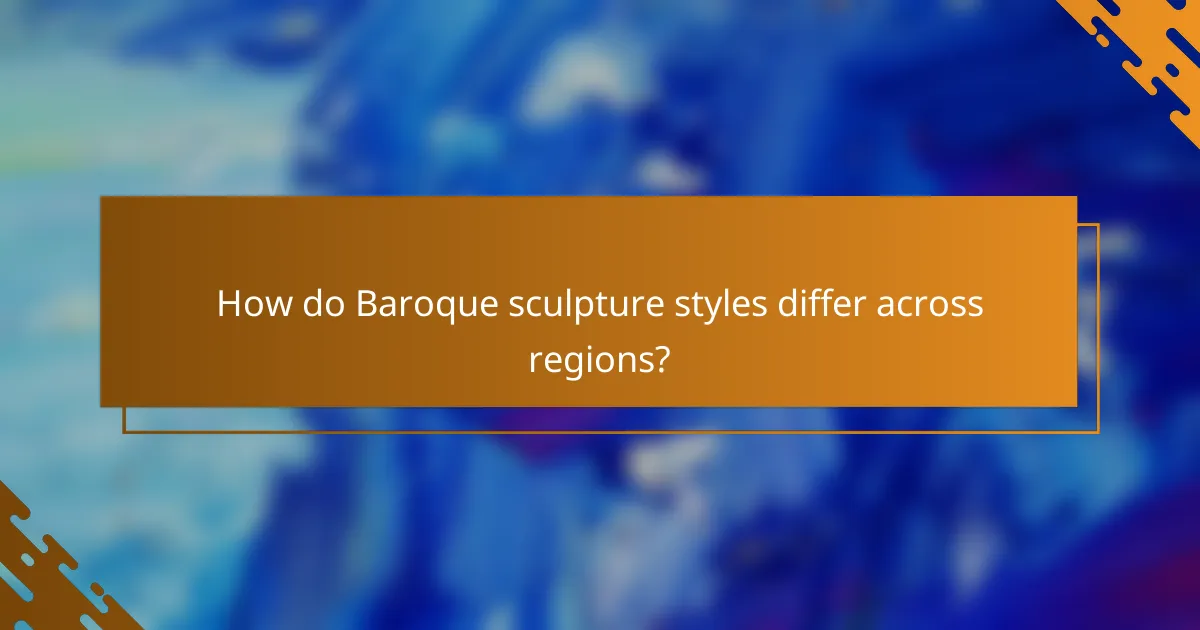
How do Baroque sculpture styles differ across regions?
Baroque sculpture styles vary significantly across regions due to cultural influences, artistic priorities, and historical contexts. Italian Baroque focuses on dramatic expression and movement, while Spanish Baroque emphasizes religious themes and emotional depth, with French and Flemish styles showcasing their unique characteristics and influences.
Italian Baroque vs. Spanish Baroque
Italian Baroque sculpture is characterized by dynamic forms, intricate details, and a strong emphasis on human emotion. Artists like Gian Lorenzo Bernini created works that conveyed movement and drama, such as “The Ecstasy of Saint Teresa,” which captures a moment of spiritual rapture.
In contrast, Spanish Baroque sculpture often highlights religious fervor and realism, reflecting the Catholic Counter-Reformation’s influence. Sculptors like Gregorio Fernández focused on lifelike representations and intense expressions, as seen in his poignant depictions of saints and the crucifixion.
French Baroque Characteristics
French Baroque sculpture is distinguished by its elegance and classical restraint, often integrating elements of grandeur and symmetry. Artists such as Nicolas Coustou and Antoine Coysevox emphasized harmony and proportion, creating works that adorned palaces and gardens, like the sculptures in the gardens of Versailles.
The French style also incorporated allegorical themes, often celebrating the monarchy and national identity. This resulted in sculptures that were not only decorative but also served to convey political messages and cultural pride.
Flemish Baroque Influences
Flemish Baroque sculpture is heavily influenced by both Italian and Spanish styles, blending dramatic expression with a focus on realism. Artists like Pieter Paul Rubens, although primarily a painter, influenced sculptural works through his dynamic compositions and emotive figures.
The use of rich materials and intricate detailing is a hallmark of Flemish Baroque, often seen in church sculptures and public monuments. This regional style emphasizes both the spiritual and the earthly, reflecting the complex cultural landscape of the Low Countries during the Baroque period.
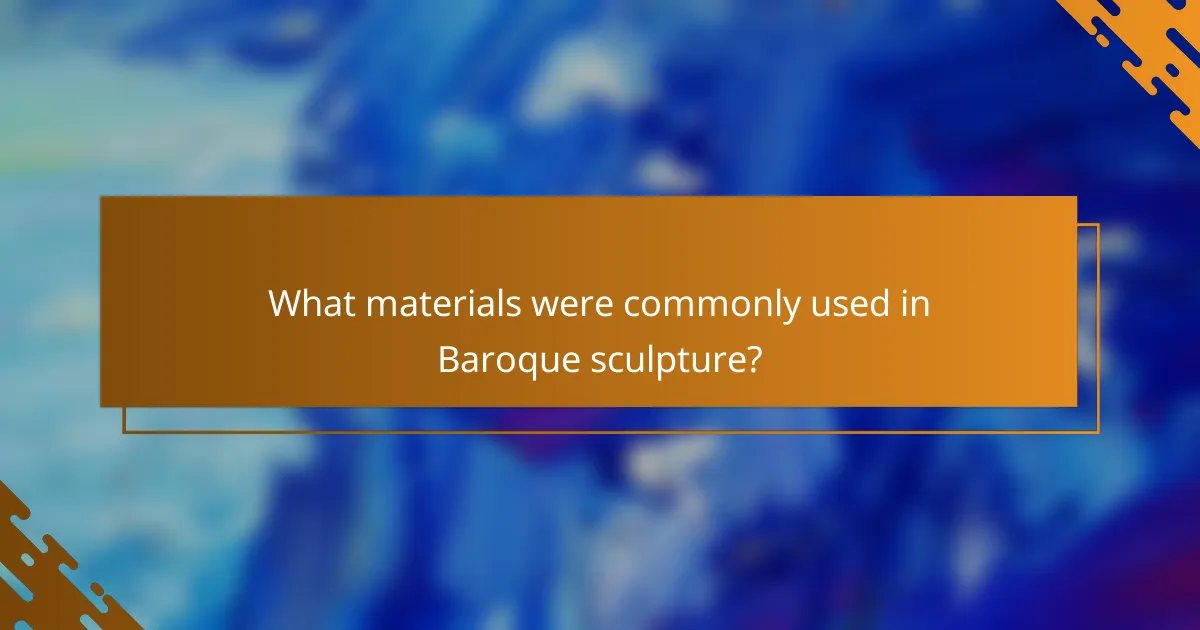
What materials were commonly used in Baroque sculpture?
Baroque sculpture primarily utilized materials such as marble, wood, and bronze, each offering unique aesthetic qualities and practical considerations. Artists selected these materials based on the desired effect, durability, and the techniques they intended to employ.
Marble
Marble was a favored material in Baroque sculpture due to its ability to convey elegance and detail. Artists often chose high-quality Carrara marble for its fine grain and translucence, allowing for intricate carvings and lifelike representations.
Working with marble requires specialized tools and techniques, including chisels and drills, to achieve the desired finish. Sculptors needed to be mindful of the stone’s hardness and potential for cracking, particularly when creating large pieces.
Wood
Wood was another important medium in Baroque sculpture, particularly for religious figures and decorative elements. Carved from varieties like oak or walnut, wooden sculptures could be painted or gilded, enhancing their visual appeal.
Wooden sculptures are generally lighter and easier to manipulate than stone, but they are also more susceptible to damage from moisture and pests. Proper treatment and maintenance are essential to preserve wooden works over time.
Bronze
Bronze was highly valued in Baroque sculpture for its strength and ability to capture fine details through casting techniques. The lost-wax method allowed artists to create complex forms and textures that were difficult to achieve with other materials.
Bronze sculptures are durable and can withstand various environmental conditions, making them suitable for both indoor and outdoor displays. However, they require careful finishing to prevent corrosion and maintain their luster.

What are the criteria for selecting Baroque sculptures for collectors?
Collectors should consider authenticity, artistic quality, provenance, and condition when selecting Baroque sculptures. These criteria help ensure that the pieces are not only valuable but also representative of the Baroque style and its historical significance.
Authenticity
Authenticity is crucial when selecting Baroque sculptures, as it confirms the piece’s origin and artistic integrity. Look for sculptures with documented provenance, including previous ownership and exhibition history. Certificates of authenticity from reputable experts can also add value and assurance.
Artistic Quality
The artistic quality of a Baroque sculpture reflects the skill of the artist and the intricacy of the work. Examine the details, such as the expressiveness of the figures, the use of light and shadow, and the overall composition. High-quality pieces often exhibit dynamic movement and emotional depth, hallmarks of the Baroque style.
Provenance
Provenance refers to the history of ownership of a sculpture, which can significantly impact its value. A well-documented provenance can enhance a piece’s desirability, especially if it has connections to notable collectors or historical events. Always verify the ownership history to avoid acquiring forgeries or replicas.
Condition
The condition of a Baroque sculpture affects both its aesthetic appeal and market value. Inspect for any damage, repairs, or alterations that may detract from its integrity. Minor wear may be acceptable, but significant restoration can lower a sculpture’s worth. Consider consulting a conservator for a professional assessment.
